Archived Mold Remediation Blog Posts
Do you see signs of Mold at your Commercial Property?
3/7/2022 (Permalink)
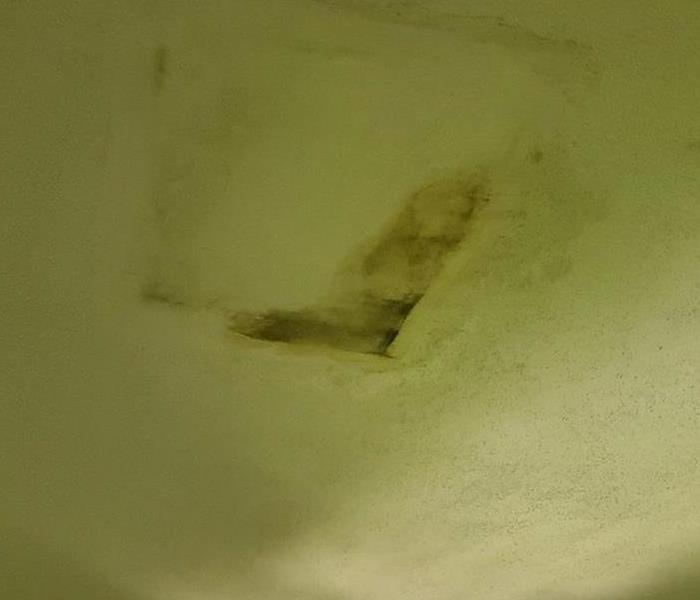 Growth on a Ceiling
Growth on a Ceiling
Microscopic mold spores naturally occur almost everywhere, both outdoors and indoors. This makes it impossible to remove all mold from a Home or Commercial Property. Therefore, mold remediation reduces the mold spore count back to its natural or baseline level. Some restoration businesses advertise “mold removal” and even guarantee to remove all mold, which is a fallacy. Consider the following mold facts:
* Mold is present almost everywhere, indoors and outdoors.
* Mold spores are microscopic and float along in the air and may enter your home through windows, doors, or AC/heating systems or even hitch a ride indoors on your clothing or a pet.
* Mold spores thrive on moisture. Mold spores can quickly grow into colonies when exposed to water. These colonies may produce allergens and irritants.
* Before mold remediation can begin, any sources of water or moisture must be addressed. Otherwise, the mold may return.
* Mold often produces a strong, musty odor and can lead you to possible mold problem areas.
* Even higher-than-normal indoor humidity can support mold growth. Keep indoor humidity below 45 percent.
If your home or business has a mold problem, we can inspect and assess your property and use our specialized training, equipment, and expertise to remediate your mold infestation.
If You See Signs of Mold, Call SERVPRO of South Tampa (813)839-6633
Quick Tips from SERVPRO of South Tampa on Preventing Mold Growth
3/23/2021 (Permalink)
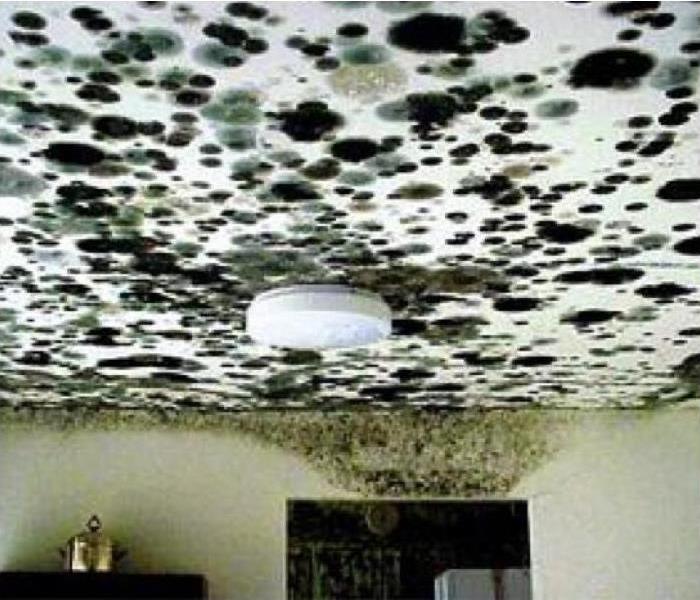 black discolored mold on white ceiling
black discolored mold on white ceiling
The rainy season has arrived, and with that the opportunity for mold growth presents itself. Due to this, we recommend that you call SERVPRO of South Tampa at the first signs of any moisture or growth. If you have discovered mold in your Tampa area home or office, we are here to help.
How mold gets into a house or building:
Mold and fungal spores occur naturally outdoors, where fungi are the earth’s most important recyclers. Indoors, mold needs moisture to grow; it becomes a problem only where there is water damage, elevated and prolonged humidity, or dampness. Common sources in the Tampa area of excessive indoor moisture that can lead to mold problems include:
* flooding from surface waters (i.e., overflowing streets) or from severe storms;
* roof leaks from damaged or missing roofing materials, blocked gutters;
* storm-driven rain through window frames, exterior walls or door assemblies;
* leaking pipes, sewer back-ups or overflows;
* damp crawl spaces due to a high water table or poorly managed rainwater drainage; and
* condensation on cold surfaces.
How to prevent mold growth:
The key to preventing and stopping indoor mold growth is to control excessive moisture and condensation. Keeping susceptible areas in the home clean and dry is critical. In general, mold will not grow indoors without water, dampness or excessive moisture.
Three main factors contribute to condensation of water on building surfaces:
* Relative Humidity: Condensation occurs when the air is saturated with water and it cannot hold any more moisture. For example, steam generated from bathroom showers or from cooking can fill up the air with moisture, which will then condense into drops of water on cooler surfaces, such as mirrors and windows. Where possible, localized sources of humidity, such as clothes dryers, should be directly vented to the outdoors. To lower indoor humidity during warm, humid weather, air conditioners should be used.
* Temperature: Warm air holds more moisture than cold air. Condensation occurs when warm humid air comes into contact with a cold surface and the moisture condenses into water. This can often be seen on single-pane windows, where water condenses and then runs down, causing the wood frames and sills to rot and the wall under the windows to blister.
* Poor Ventilation: Indoor humidity can build up if there is not enough ventilation and exchange of indoor and outdoor air. Where there is little or no air movement, such as behind dressers and cabinets, surfaces can remain cooler than surrounding areas, which can lead to increased condensation and mold growth. It is recommended that the area is ventilated and the occupants use exhaust fans (vented to the outdoors) to remove moisture from high-humidity areas, particularly in bathrooms, kitchens, and laundry areas. Furniture should be moved slightly away from walls so that air can freely pass behind it. Air should be allowed to circulate between rooms and regularly ventilate to remove humid air. Fans should be used as needed.
Other things that can be done are to clean and repair gutters regularly, make sure the ground slopes down and away from the home’s foundation and keep air conditioner drip pans and drain lines clean. In addition, in air-conditioned buildings in hot and humid climates, vinyl wall coverings on the interior sides of exterior walls should not be used, as these materials can trap moisture, resulting in mold growth underneath them.
In the case of floods or leaking pipes, any standing water should be promptly removed and water-damaged materials should either be dried out and cleaned, or removed and replaced. Porous materials that are wet for more than 48 hours are likely to produce mold growth and should be discarded. In instances where the water damage is extensive, it is recommended that you call SERVPRO of South Tampa at (813) 839-6633, so that we may assist you in preventing growth after water damage, or to remove the mold if it is already an issue.
Do you see signs of mold?
3/22/2021 (Permalink)
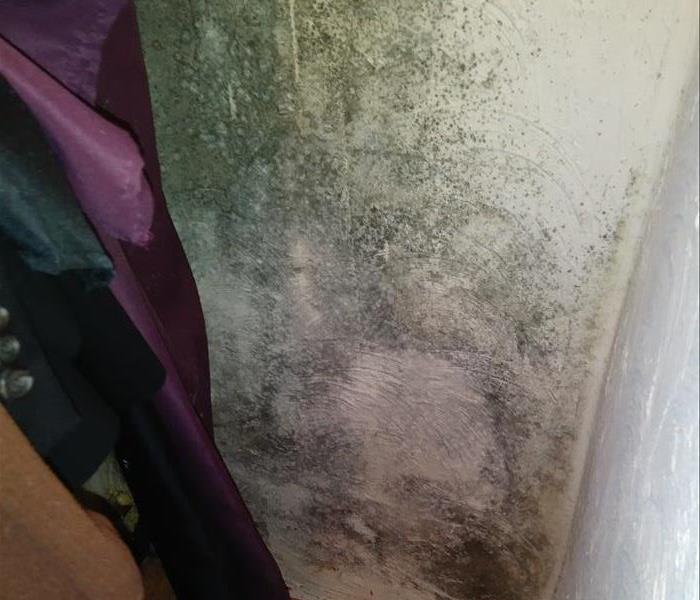 growth on wall, purple fabric on left side behind furniture
growth on wall, purple fabric on left side behind furniture
Microscopic mold spores naturally occur almost everywhere, both outdoors and indoors. This makes it impossible to remove all mold from a home or business. Therefore, mold remediation reduces the mold spore count back to its natural or baseline level. Some restoration businesses advertise “mold removal” and even guarantee to remove all mold, which is a fallacy. Consider the following mold facts:
* Mold is present almost everywhere, indoors and outdoors.
* Mold spores are microscopic and float along in the air and may enter your home through windows, doors, or AC/heating systems or even hitch a ride indoors on your clothing or a pet.
* Mold spores thrive on moisture. Mold spores can quickly grow into colonies when exposed to water. These colonies may produce allergens and irritants.
* Before mold remediation can begin, any sources of water or moisture must be addressed. Otherwise, the mold may return.
* Mold often produces a strong, musty odor and can lead you to possible mold problem areas.
* Even higher-than-normal indoor humidity can support mold growth. Keep indoor humidity below 45 percent.
If your home or business has a mold problem, we can inspect and assess your property and use our specialized training, equipment, and expertise to remediate your mold infestation.
If You See Signs of Mold, Call SERVPRO of South Tampa (813)839-6633
The 8 Most common areas for mold growth in Tampa
1/14/2020 (Permalink)
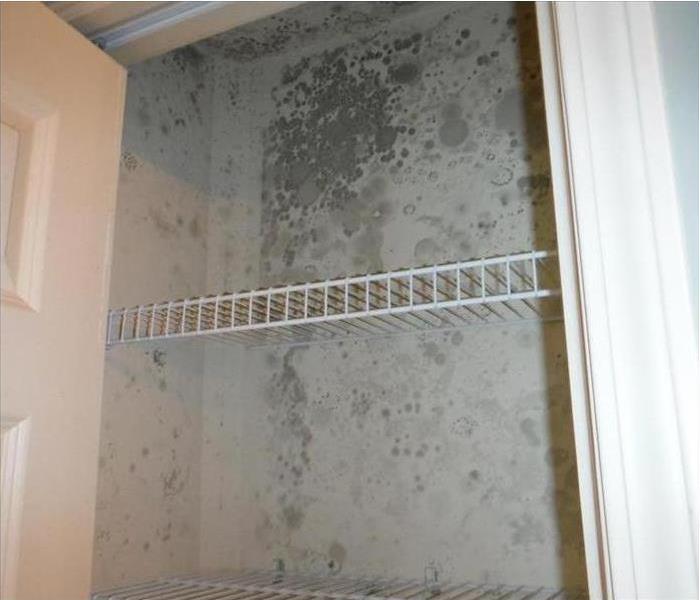 Mold growth in Tampa
Mold growth in Tampa
According to the Environmental Protection Agency (EPA) mold can grow on virtually any organic material as long as moisture and oxygen are present. There are molds that grow on wood, paper, carpet, food, and insulation. Because mold eats or digests what it's growing on, it can damage a building and its furnishings. If left unchecked, mold eventually can cause structural damage to building materials.
8 Places to Watch for Mold Growth in Your Home:Basements or cellars that have been flooded :
- Underneath kitchen sinks
- Underneath or behind refrigerators
- Bathroom shower or under sink
- Behind walls that also home plumbing
- Stacks of damp or wet newspaper or cardboard boxes
- Around air-conditioning units
- Wallboard or around windows that leak
- Under carpeting that may have become wet
Attics & Crawl Spaces
Conditions In Tampa, Florida Might Be Right For Mold
12/14/2019 (Permalink)
It’s estimated that more than 1 million types of mold exist, yet less than 10 percent have actually been named. This means mold is very common in both indoor and outdoor environments. While mold and humans can sometimes co-exist without issue, there are certain species of mold that can cause health effects for some people.
If the right conditions exist, mold will grow. Those conditions include:
- Water - Different mold types require varying amounts of liquid before growth begins.
- Temperature - Normal indoor temperatures will promote mold growth.
- Time - Initial mold colonizers can take hold within one day after being exposed to an adequate water supply.
Mold growth can occur in any home, so it’s important to keep an eye out for situations that might promote mold activity. Roof/chimney leaks, wet basements, or condensation from ducts that dampen surrounding insulation are just a few examples of issues that make a house a prime target for mold growth.
If you suspect mold in your home, call SERVPRO of South Tampa to assess the situation. We have the knowledge, tools and track record to effectively remediate mold in your home or business.
If you suspect mold, call us today at (813) 839-6633
What to Do:
- Stay out of affected areas.
- Turn off the HVAC system and fans.
- Contact SERVPRO of South Tampa for mold remediation services.
Tampa, Florida Residents: Follow These Mold Safety Tips If You Suspect Mold
12/7/2019 (Permalink)
If you see visible mold, do not disturb it. You can inadvertently spread the mold infestation throughout your home. When mold is disturbed, the mold can release microscopic mold spores which become airborne and can circulate inside your home.
What to Do:
- Stay out of affected areas.
- Turn off the HVAC system and fans.
- Contact SERVPRO of South Tampa for mold remediation services.
What Not to Do:
- Don’t touch or disturb the mold.
- Don’t blow air across any surfaces with visible or suspected mold growth.
- Don’t attempt to dry the area yourself.
- Don’t spray bleach or other disinfectants on the mold.
About Our Mold Remediation Services
SERVPRO of South Tampa specializes in mold cleanup and restoration, in fact, it’s a cornerstone of our business. Our crews are highly trained restoration professionals that use specialized equipment and techniques to properly remediate your mold problem quickly and safely.
If You See Signs of Mold, Call Us Today –(813) 839-6633
In Tampa, Florida mold can spread through a home in as little as 48 hours.
11/30/2019 (Permalink)
Microscopic mold spores naturally occur almost everywhere, both outdoors and indoors. This makes it impossible to remove all mold from a home or business. Therefore, mold remediation reduces the mold spore count back to its natural or baseline level. Some restoration businesses advertise “mold removal” and even guarantee to remove all mold, which is a fallacy. Consider the following mold facts:
- Mold is present almost everywhere, indoors and outdoors.
- Mold spores are microscopic and float along in the air and may enter your home through windows, doors, or AC/heating systems or even hitch a ride indoors on your clothing or a pet.
- Mold spores thrive on moisture. Mold spores can quickly grow into colonies when exposed to water. These colonies may produce allergens and irritants.
- Before mold remediation can begin, any sources of water or moisture must be addressed. Otherwise, the mold may return.
- Mold often produces a strong, musty odor and can lead you to possible mold problem areas.
- Even higher-than-normal indoor humidity can support mold growth. Keep indoor humidity below 45 percent.
If your home or business has a mold problem, we can inspect and assess your property and use our specialized training, equipment, and expertise to remediate your mold infestation.
If You See Signs of Mold, Call Us Today – (813) 839-6633
Does South Tampa Home Have A Mold Problem?
9/23/2018 (Permalink)
Microscopic mold spores naturally occur almost everywhere, both outdoors and indoors. This makes it impossible to remove all mold from a home or business. Therefore, mold remediation reduces the mold spore count back to its natural or baseline level. Some restoration businesses advertise “mold removal” and even guarantee to remove all mold, which is a fallacy. Consider the following mold facts:
- Mold is present almost everywhere, indoors and outdoors.
- Mold spores are microscopic and float along in the air and may enter your home through windows, doors, or AC/heating systems or even hitch a ride indoors on your clothing or a pet.
- Mold spores thrive on moisture. Mold spores can quickly grow into colonies when exposed to water. These colonies may produce allergens and irritants.
- Before mold remediation can begin, any sources of water or moisture must be addressed. Otherwise, the mold may return.
- Mold often produces a strong, musty odor and can lead you to possible mold problem areas.
- Even higher-than-normal indoor humidity can support mold growth. Keep indoor humidity below 45 percent.
If your home or business has a mold problem, we can inspect and assess your property and use our specialized training, equipment, and expertise to remediate your mold infestation.
If You See Signs of Mold, Call Us Today – (813) 839-6633
Mold Damage and The Facts You Should Know
12/7/2016 (Permalink)
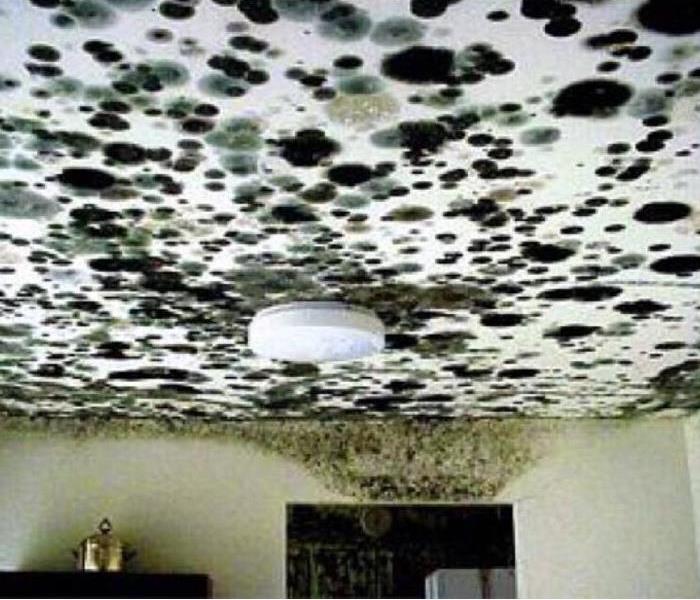 Cleaning mold, when found, should be done very carefully in order not to spread it to other areas that may not currently have a mold issue.
Cleaning mold, when found, should be done very carefully in order not to spread it to other areas that may not currently have a mold issue.
The presence of mold is a fact of life all over the world. There is a wide range of mold varieties that can live in almost any location. Mold in minute amounts poses very little risk and is found in even the cleanest of homes. It is when mold colonies become too large, or they are disturbed by either wind or movement around the mold, that the mold spreads sending off spores to colonize other areas. Mold is impossible to eradicate – there is no such thing, although remediation is quite possible even in the worst mold situations.
In Tampa, many homeowners want to learn more about mold damage and what it means to them. Much of the information about mold searched for online focuses on black mold. However, all mold can create harmful affects. The color does not matter.
Mold is also found everywhere. Mold is found in dry locations, as well as moist ones. It is in the moister, more humid areas that can grow most easily, but those located in drier areas only need to wait for moisture to find them before they can grow and send off spores of their own. SERVPRO of South Tampa professionals are trained in handling mold so that it does not spread, and is contained adequately during the removal process. We also know how to repair mold damage, and when restoration work should include replacing materials. Our goal is restoring a safe environment.
Cleaning mold, when found, should be done very carefully in order not to spread it to other areas that may not currently have a mold issue. Cleaning mold by the homeowner should only be done if the area is very small, and never with bleach. Bleach can only change the color of the mold, living you a false sense of safety and accomplishment. The spores are still viable, and the mycotoxins still present. The odor is now masked, and temporarily, by the smell of the chlorine. The problem is that with bleach, and especially a bleach solution, the mold has been fed some water, and the bleach will help break down any organic compounds that are present. This provides additional nutrients the mold needs to thrive.
Locally Owned Company with National Resources
Wherever you've found mold, perhaps in your attic or garage, it may have a moist appearance, or may seem to be dry. It is best not to disturb any mold found, but instead call SERVPRO of South Tampa for professional assistance. You can contact SERVPRO of South Tampa (813)839-6633 24/7 and we will come to your home at your convenience.
Quick Tips from SERVPRO of South Tampa on Preventing Mold Growth
9/13/2016 (Permalink)
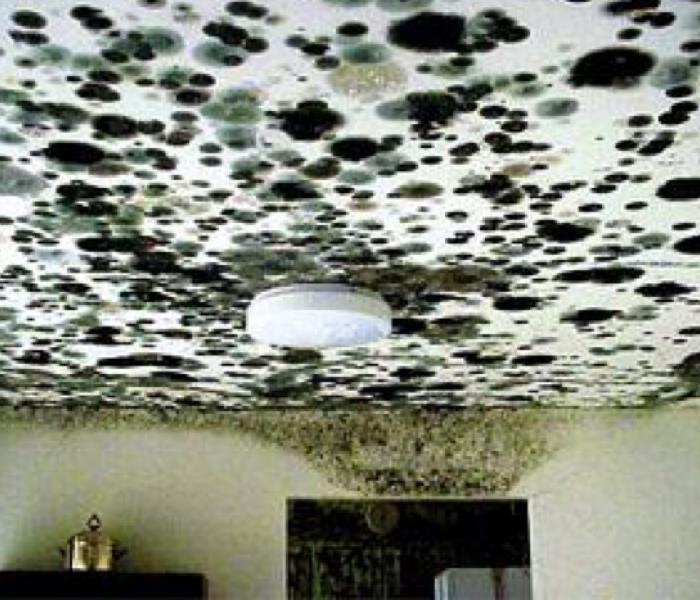 Growth can occur in anyone's home or office if you think you might have an issue, give SERVPRO of South Tampa a call and we will be able to assist.
Growth can occur in anyone's home or office if you think you might have an issue, give SERVPRO of South Tampa a call and we will be able to assist.
The rainy season has arrived, and with that the opportunity for mold growth presents itself. Due to this, we recommend that you call SERVPRO of South Tampa at the first signs of any moisture or growth. If you have discovered mold in your Tampa area home or office, we are here to help.
How mold gets into a house or building
Mold and fungal spores occur naturally outdoors, where fungi are the earth’s most important recyclers. Indoors, mold needs moisture to grow; it becomes a problem only where there is water damage, elevated and prolonged humidity, or dampness. Common sources in the Tampa area of excessive indoor moisture that can lead to mold problems include:
* flooding from surface waters (i.e., overflowing streets) or from severe storms;
* roof leaks from damaged or missing roofing materials, blocked gutters;?
* storm-driven rain through window frames, exterior walls or door assemblies;?
* leaking pipes, sewer back-ups or overflows;?
* damp crawl spaces due to a high water table or poorly managed rainwater drainage; and?
* condensation on cold surfaces.?
How to prevent mold growth
The key to preventing and stopping indoor mold growth is to control excessive moisture and condensation. Keeping susceptible areas in the home clean and dry is critical. In general, mold will not grow indoors without water, dampness or excessive moisture.
Three main factors contribute to condensation of water on building surfaces:
* Relative Humidity: Condensation occurs when the air is saturated with water and it cannot hold any more moisture. For example, steam generated from bathroom showers or from cooking can fill up the air with moisture, which will then condense into drops of water on cooler surfaces, such as mirrors and windows. Where possible, localized sources of humidity, such as clothes dryers, should be directly vented to the outdoors. To lower indoor humidity during warm, humid weather, air conditioners should be used.?
* Temperature: Warm air holds more moisture than cold air. Condensation occurs when warm humid air comes into contact with a cold surface and the moisture condenses into water. This can often be seen on single-pane windows, where water condenses and then runs down, causing the wood frames and sills to rot and the wall under the windows to blister. ?
* Poor Ventilation: Indoor humidity can build up if there is not enough ventilation and exchange of indoor and outdoor air. Where there is little or no air movement, such as behind dressers and cabinets, surfaces can remain cooler than surrounding areas, which can lead to increased condensation and mold growth. It is recommended that the area is ventilated and the occupants use exhaust fans (vented to the outdoors) to remove moisture from high-humidity areas, particularly in bathrooms, kitchens, and laundry areas. Furniture should be moved slightly away from walls so that air can freely pass behind it. Air should be allowed to circulate between rooms and regularly ventilate to remove humid air. Fans should be used as needed.?
Other things that can be done are to clean and repair gutters regularly, make sure the ground slopes down and away from the home’s foundation and keep air conditioner drip pans and drain lines clean. In addition, in air conditioned buildings in hot and humid climates, vinyl wall coverings on the interior sides of exterior walls should not be used, as these materials can trap moisture, resulting in mold growth underneath them.
In the case of floods or leaking pipes, any standing water should be promptly removed and water-damaged materials should either be dried out and cleaned, or removed and replaced. Porous materials that are wet for more than 48 hours are likely to produce mold growth and should be discarded. In instances where the water damage is extensive, it is recommended that you call SERVPRO of South Tampa at (813) 839-6633, so that we may assist you in preventing growth after water damage, or to remove the mold if it is already an issue.
Does Your Tampa Home Have A Mold Problem?
8/12/2016 (Permalink)
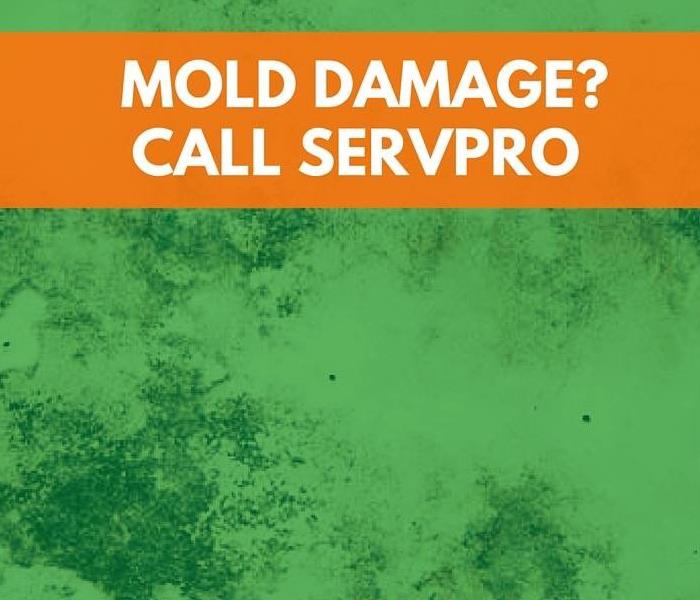 In Tampa Fl. mold can spread through a home in as little as 48 hours.
In Tampa Fl. mold can spread through a home in as little as 48 hours.
Microscopic mold spores naturally occur almost everywhere, both outdoors and indoors. This makes it impossible to remove all mold from a home or business. Therefore, mold remediation reduces the mold spore count back to its natural or baseline level. Some restoration businesses advertise “mold removal” and even guarantee to remove all mold, which is a fallacy. Consider the following mold facts:
* Mold is present almost everywhere, indoors and outdoors.
* Mold spores are microscopic and float along in the air and may enter your home through windows, doors, or AC/heating systems or even hitch a ride indoors on your clothing or a pet.
* Mold spores thrive on moisture. Mold spores can quickly grow into colonies when exposed to water. These colonies may produce allergens and irritants.
* Before mold remediation can begin, any sources of water or moisture must be addressed. Otherwise, the mold may return.
* Mold often produces a strong, musty odor and can lead you to possible mold problem areas.
* Even higher-than-normal indoor humidity can support mold growth. Keep indoor humidity below 45 percent.
If your home or business has a mold problem, we can inspect and assess your property and use our specialized training, equipment, and expertise to remediate your mold infestation.
If You See Signs of Mold, Call SERVPRO of South Tampa (813)839-6633






 24/7 Emergency Service
24/7 Emergency Service





